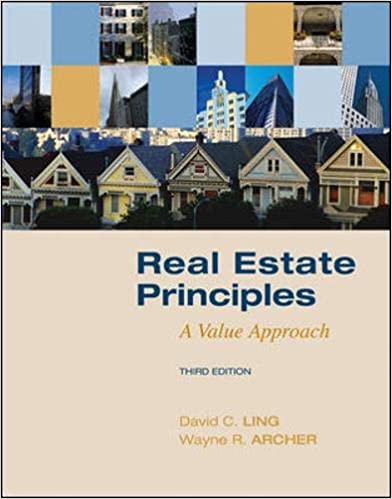
Real Estate Principles 3rd Edition by David Ling,Wayne Archer
Edition 3ISBN: 978-0073377322
Real Estate Principles 3rd Edition by David Ling,Wayne Archer
Edition 3ISBN: 978-0073377322 Exercise 21
A real estate investor is considering purchasing a small warehouse. Analysis has resulted in the following facts:
• The asking price is $450,000.
• There are 10,000 square feet of leasable area.
• The expected rent is $5 per square foot per year; rents are expected to increase 5 percent per year. Since the property is leased to an AAA-grade tenant for 25 more years, no vacancy factor is deducted.
• The tenant will pay all operating expenses except property taxes and insurance. These two expenses will equal 20 percent of the effective gross income ( EGI ) each year.
• The investor can borrow 80 percent of the total cost for 20 years at an interest rate of 7 percent with monthly payments and up-front financing costs equal to 3 percent of the amount borrowed.
• 85 percent of the total acquisition cost is depreciable over the useful life of 39 years using the straight-line method (no personal property).
• The investor expects to sell the investment at the end of year 5.
• The investor's ordinary income tax rate is 30 percent.
• No capital expenditures have been made since acquisition.
Compute the after-tax cash flows from annual rental operations over the five-year housing period.
• The asking price is $450,000.
• There are 10,000 square feet of leasable area.
• The expected rent is $5 per square foot per year; rents are expected to increase 5 percent per year. Since the property is leased to an AAA-grade tenant for 25 more years, no vacancy factor is deducted.
• The tenant will pay all operating expenses except property taxes and insurance. These two expenses will equal 20 percent of the effective gross income ( EGI ) each year.
• The investor can borrow 80 percent of the total cost for 20 years at an interest rate of 7 percent with monthly payments and up-front financing costs equal to 3 percent of the amount borrowed.
• 85 percent of the total acquisition cost is depreciable over the useful life of 39 years using the straight-line method (no personal property).
• The investor expects to sell the investment at the end of year 5.
• The investor's ordinary income tax rate is 30 percent.
• No capital expenditures have been made since acquisition.
Compute the after-tax cash flows from annual rental operations over the five-year housing period.
Explanation
* includes amortiza...
Real Estate Principles 3rd Edition by David Ling,Wayne Archer
Why don’t you like this exercise?
Other Minimum 8 character and maximum 255 character
Character 255


